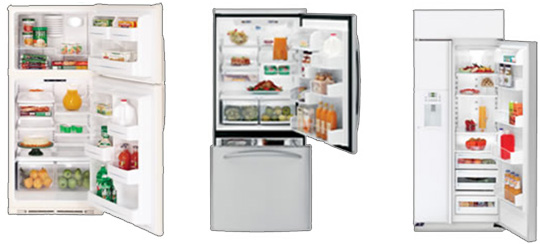Refrigerators are heat movers, which move heat from a low temperature (inside the refrigerator) to a high temperature (outside the refrigerator into the kitchen). Heat movers do not produce any heat, but just move from one location to another. (Note: The animation has no audio.)
How Does a Refrigerator Work?
The principle of operation of a refrigerator is similar to an air conditioner. It moves the heat energy from inside to outside. There are four basic components in a refrigerator and their functions are as follows:
- Expansion valve - A liquid refrigerant at high pressure flows through an expansion valve. As the refrigerant moves through the expansion valve, it moves from a high-pressure zone to a low-pressure zone. The decrease in pressure corresponds with a decrease in temperature.
- Evaporator or heat exchanging pipes - A set of coiled tubes carrying the low pressure, expanded refrigerant. In the evaporator, the liquid refrigerant also expands and evaporates. The evaporation of liquid takes away heat, creating cold gas in the coils. The cold refrigerant flowing through the coils absorbs heat from the refrigerator. The food gets cold. However, the refrigerant warms up because of the absorption of heat.
- Compressor - A device that pressurizes the warm refrigerant and makes it hot (hotter than the kitchen temperature). This hot refrigerant goes into the condenser.
- Condenser or second heat exchanger coil - Located at the back of the refrigerator where it gives off the heat to the air in the kitchen.
Click the “play” button to learn how a refrigerator works.
Click here to open a text description of how a refrigerator works.
How a Refrigerator Works
Compressed liquid refrigerant passes through an expansion valve that reduces the pressure and, in turn, the temperature. The now cold liquid travels through a series of evaporator coils. As it travels through the coils, the liquid evaporates, drawing the heat energy needed for evaporation from the food in the fridge. This process leaves the food cold as the heat has been moved to the refrigerant.
The evaporated refrigerant passes through a compressor that raises the pressure and temperature of the refrigerant and turns it back into a liquid. The liquid dispenses the heat collected from inside the fridge through the condenser coils and then passes through the expansion valve again to repeat the process.
Types and Features
There are four types of refrigerators: top-freezer (or top-mount), bottom-freezer (or bottom-mount), side-by-side, and built-in (as shown below).
Refrigerators also come in four size categories: small (7 to 9.9 cubic feet), medium (10 to 13.9 cubic feet), large (14 to 19.9 cubic feet), and extra large (20 to 29 cubic feet).
